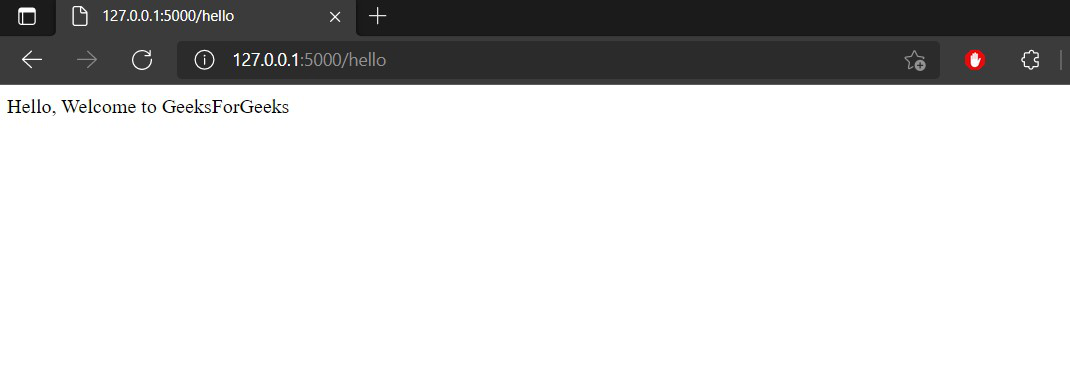Flask App Routing
Last Updated :
10 Mar, 2023
App Routing means mapping the URLs to a specific function that will handle the logic for that URL. Modern web frameworks use more meaningful URLs to help users remember the URLs and make navigation simpler.
Example: In our application, the URL (“/”) is associated with the root URL. So if our site’s domain was www.example.org and we want to add routing to “www.example.org/hello”, we would use “/hello”.
To bind a function to an URL path we use the app.route decorator. In the below example, we have implemented the above routing in the flask.
main.py
from flask import Flask
app = Flask(__name__)
@app.route("/hello")
def hello():
return "Hello, Welcome to GeeksForGeeks"
@app.route("/")
def index():
return "Homepage of GeeksForGeeks"
if __name__ == "__main__":
app.run(debug=True)
|
The hello function is now mapped with the “/hello” path and we get the output of the function rendered on the browser.
Step to run the application: Run the application using the following command.
python main.py
Output: Open the browser and visit 127.0.0.1:5000/hello, you will see the following output.

Dynamic URLs – We can also build dynamic URLs by using variables in the URL. To add variables to URLs, use <variable_name> rule. The function then receives the <variable_name> as keyword argument.
Example: Consider the following example to demonstrate the dynamic URLs.
main.py
from flask import Flask
app = Flask(__name__)
@app.route('/user/<username>')
def show_user(username):
return f'Hello {username} !'
@app.route("/hello")
def hello():
return "Hello, Welcome to GeeksForGeeks"
@app.route("/")
def index():
return "Homepage of GeeksForGeeks"
if __name__ == "__main__":
app.run(debug=True)
|
Step to run the application: Run the application using the following command.
python main.py
Output: Open the browser and visit 127.0.0.1:5000/user/geek, you will see the following output.

Additionally, we can also use a converter to convert the variable to a specific data type. By default, it is set to string values. To convert use <converter:variable_name> and following converter types are supported.
- string: It is the default type and it accepts any text without a slash.
- int: It accepts positive integers.
- float: It accepts positive floating-point values.
- path: It is like a string but also accepts slashes.
- uuid: It accepts UUID strings.
Example: Consider the following example to demonstrate the converter type.
main.py
from flask import Flask
app = Flask(__name__)
@app.route('/post/<int:id>')
def show_post(id):
return f'This post has the id {id}'
@app.route('/user/<username>')
def show_user(username):
return f'Hello {username} !'
@app.route("/hello")
def hello():
return "Hello, Welcome to GeeksForGeeks"
@app.route("/")
def index():
return "Homepage of GeeksForGeeks"
if __name__ == "__main__":
app.run(debug=True)
|
Step to run the application: Run the application using the following command.
python main.py
Output: Open the browser and visit 127.0.0.1:5000/post/13, you will see the following output.

The add_url_rule() function – The URL mapping can also be done using the add_url_rule() function. This approach is mainly used in case we are importing the view function from another module. In fact, the app.route calls this function internally.
Syntax:
add_url_rule(<url rule>, <endpoint>, <view function>)
Example: In the below example, we will try to map the show_user view function using this approach.
main.py
from flask import Flask
app = Flask(__name__)
def show_user(username):
return f'Hello {username} !'
app.add_url_rule('/user/<username>', 'show_user', show_user)
if __name__ == "__main__":
app.run(debug=True)
|
Step to run the application: Run the application using the following command.
python main.py
Output: Open the browser and visit 127.0.0.1:5000/user/pulkit, you will see the following output.

Like Article
Suggest improvement
Share your thoughts in the comments
Please Login to comment...